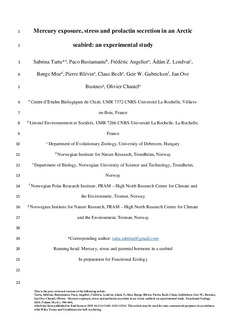| dc.description.abstract | Life-history theory predicts that long-lived organisms should reduce parental effort under inclement environmental conditions in order to favour long-term survival. Seabirds are long-lived top predators often exposed to environmental endocrine disrupting chemicals such as mercury (Hg). Hg contaminated birds show disrupted parental behaviour. Avian parental behaviour is governed by two key hormones in birds: corticosterone (CORT, a glucocorticoid hormone) and prolactin (PRL, a pituitary hormone involved in parental care). Any disruption of these hormones may alter the ability of an individual to adjust parental behaviour to environmental conditions. The first aim of this study was to describe the relationships between blood Hg concentrations, plasma PRL and reproductive performance in Arctic black-legged kittiwakes (Rissa tridactyla). We a found negative relationship between plasma initial PRL and blood Hg concentrations in males. Moreover, Hg concentration was negatively related to breeding success in chick-rearing males. Second, to study the effect of a chronic increase of CORT levels on the Hg-PRL relationship, we experimentally increased stress with CORT pellet implantation. We predicted that Hg and CORT would act synergistically on PRL and an increase of CORT concentration would steepen the Hg-PRL relationship. However, adding CORT did not steepen the Hg-PRL relationship. Hatching success was significantly lower in CORT implanted males than in controls, breeding success was not reduced in CORT implanted male kittiwakes with high levels of blood Hg. Our results suggest that Hg may impair reproductive performance through a disruption of PRL secretion. Contrary to our prediction Hg and CORT did not act synergistically, the underlying mechanisms associating CORT and Hg with PRL, might be more complex than a single interaction of two factors. arctic, black-legged kittiwake, breeding success, contaminants, corticosterone, endocrine disruptors, parental investment, parenting hormone | nb_NO |
